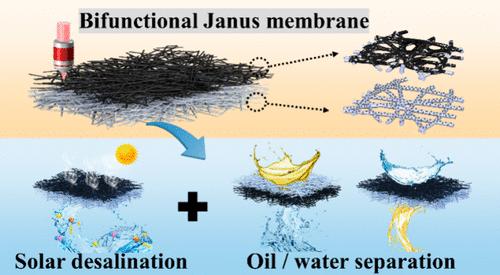Bifunctional Janus Membranes for Multicomponent Contaminated Seawater Separation and Recovery
IF 8.2
2区 材料科学
Q1 MATERIALS SCIENCE, MULTIDISCIPLINARY
引用次数: 0
Abstract
Solar-driven interface desalination has emerged as a promising strategy to address the global freshwater shortage crisis. However, the separation and recovery of multicomponent oil-contaminated seawater remain a key challenge. This study reports a novel high-strength Janus photothermal membrane with a unique reverse wettability design. On one side, the membrane has hydrophilic and oleophobic properties, while on the other, it has hydrophobic and oleophilic characteristics. The Janus membrane demonstrates dual functionality: solar desalination and oil–water separation. This dual functionality enables efficient separation and recovery of four components from contaminated seawater: purified water, salt crystals, light oil, and heavy oil. As a result, the Janus membrane achieves an evaporation rate of 2.06 kg m–2 h–1 under 1.0 sun. The ion (Na+, K+, Ca2+, and Mg2+) removal rate approaches 100% with nearly complete recovery of salt crystals. Furthermore, various types of oils can be accurately separated, with separation efficiency approaching 100%. An integrated separation device successfully separates and recovers the four components. This research presents significant potential for efficient separation and recovery of complex components in oil-contaminated seawater.

用于多组分污染海水分离和回收的双功能 Janus 膜
太阳能驱动的界面海水淡化已成为解决全球淡水短缺危机的一项前景广阔的战略。然而,如何分离和回收被石油污染的多组分海水仍是一项关键挑战。本研究报告了一种新型高强度 Janus 光热膜,该膜具有独特的反向润湿性设计。膜的一面具有亲水和疏油特性,另一面具有疏水和亲油特性。Janus 膜具有双重功能:太阳能脱盐和油水分离。这种双重功能可以从受污染的海水中有效分离和回收四种成分:纯净水、盐晶体、轻油和重油。因此,Janus 膜在 1.0 阳光下的蒸发率可达 2.06 kg m-2 h-1。离子(Na+、K+、Ca2+ 和 Mg2+)去除率接近 100%,盐结晶几乎完全回收。此外,还能准确分离各种油类,分离效率接近 100%。集成分离装置成功分离并回收了四种成分。这项研究为高效分离和回收石油污染海水中的复杂成分提供了巨大的潜力。
本文章由计算机程序翻译,如有差异,请以英文原文为准。
求助全文
约1分钟内获得全文
求助全文
来源期刊

ACS Applied Materials & Interfaces
工程技术-材料科学:综合
CiteScore
16.00
自引率
6.30%
发文量
4978
审稿时长
1.8 months
期刊介绍:
ACS Applied Materials & Interfaces is a leading interdisciplinary journal that brings together chemists, engineers, physicists, and biologists to explore the development and utilization of newly-discovered materials and interfacial processes for specific applications. Our journal has experienced remarkable growth since its establishment in 2009, both in terms of the number of articles published and the impact of the research showcased. We are proud to foster a truly global community, with the majority of published articles originating from outside the United States, reflecting the rapid growth of applied research worldwide.
 求助内容:
求助内容: 应助结果提醒方式:
应助结果提醒方式:


